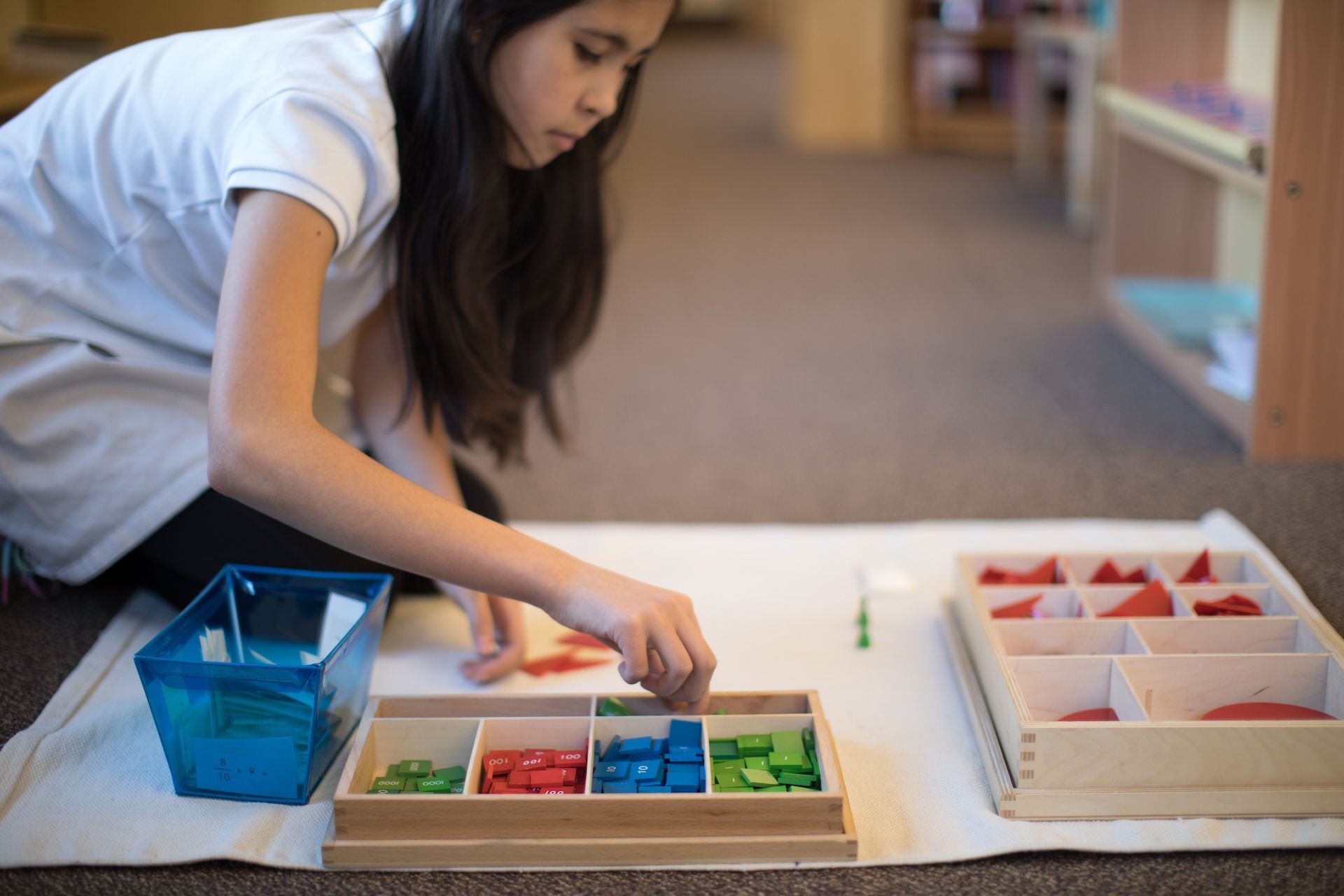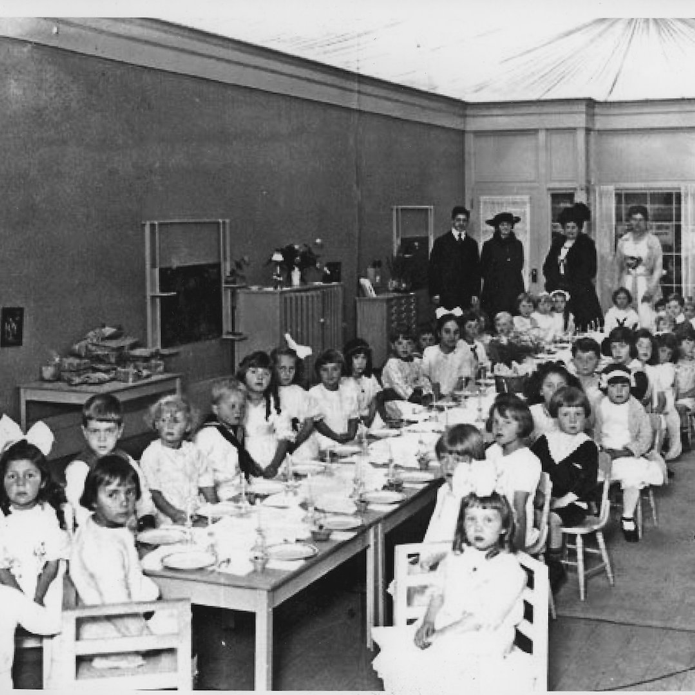


This article is part of a series that we will share throughout the 2020-2021 school year to celebrate the 150th birthday of Dr. Maria Montessori. Check back often for more posts that reflect on the past, present, and future of Montessori education.
The Glass Classroom
Seeing is believing when it comes to Montessori. It is quite rare to meet a person who has visited and observed in a high-fidelity Montessori school that is then critical of the methods. Since observation is such a core element of the work we do, we have welcomed outsiders from the very beginning to take a look for themselves.
In 1915 there was a world fair, The Panama-Pacific International Exposition, in San Francisco. The affair stretched out over many months, took over hundreds of acres, and was visited by more than 18 million people.
Maria Montessori held an exhibit at the fair, which has gone down in history as a major stepping stone to informing Americans about Montessori education. The Glass Classroom, which visitors could see into, showed the public just what went on inside a Montessori school. Visitors were astounded by what they saw.
A Day in the Life of a Primary Environment
The tradition of the Glass Classroom continues even today. Many Montessori schools have observation windows so that parents and visitors can take a peek inside without being noticed. All Montessori schools encourage adults to observe - window or not. We feel it’s the best way to fully understand what goes on, and we know every person who does so is amazed.
COVID has made this special tradition a bit more challenging to continue, so we thought it might be nice to take you on a written journey to get a sense of what the day is like. We hope that when the time is right, we will get to welcome you back into our classrooms again!
Early morning, before the children arrive
The guide arrives, hangs their coat, changes their shoes, and admires the beautiful classroom environment upon entering. So much love and attention to detail has been put into the creation of this space, with small changes being made throughout the year to better serve the ever-evolving needs of the children.
The guide makes a cup of tea, puts on some relaxing music, turns on the lights, and gets to work reviewing the plans for the day. If any materials need to be prepared (or repaired!), this is done. Pencils are sharpened and chairs set down. As colleagues trickle in, they take a moment or two to check in with one another.
Drop-off time!
A flurry of cars descends upon the campus, and children hop out of back seats with bags and coats in tow. Independently, the children make their way to their classrooms, hang their own coats, and change their shoes. Their guide stands in the doorway, and they cheerfully (or sleepily) greet one another with a smile.
The child walks through the doorway, takes in the sight of the room, and prepares to work.
The morning work cycle
The first 2.5 - 3 hours of each day is dedicated to the morning work cycle. This allows children to sink deeply into their work, and the flexible schedule means children will transition as they are ready and will work independently according to their own personal needs.
A three-year-old sits on a large area rug, with a work mat beneath the pink tower, which she is carefully stacking higher and higher. She carefully compares the sizes of the blocks, making adjustments as needed so that they become smaller as they ascend.
Several four-year-olds sit together at a table, working in silence to create maps. One child uses a small tool to poke holes in colored paper, creating neat perforations in the shape of South America. Another uses watercolor paint to shape two blue spheres on a large piece of white paper. The third, who has previously completed the other two steps, is seen gluing their continents onto the painted hemispheres.
At the next table over, the guide is sitting with a five-year-old to give an initial lesson with the stamp game material. This particular child has an affinity for math and is ready to move on to more challenging work. Today they will begin adding larger numbers.
Two friends have decided they need a break. They have been enjoying a snack together at a designated table, and as they finish, they take their dishes to the sink and wash them in a prepared bin of soapy water. After rinsing the dishes, they leave them in the rack to dry.
The classroom is not silent by any means. There is a gentle hum, with most working quietly. They all seem engaged in whatever they are doing - even the very youngest students. One small child is seen wandering around the room. They aren’t working, but they aren’t disturbing the work of anyone else, either. This goes on for about ten minutes or so, at which point they select a material from the shelf and get started. They were able to move around and take the time they needed to transition, and they were trusted to make their own decisions.
As the work cycle draws to a close, children put their materials carefully on the shelves and the guide gathers students for a daily circle time. During this time of togetherness, our children have the opportunity to learn songs and sing together in both English and Chinese, engage in group discussion, and share with their friends.
Transition to midday
As the clock nears midday, children get ready for lunch and outdoor time. At lunch, the children sit individually at tables and unpack their meals. There is laughter, sweet conversation, and a chance to refuel after the hard work of the morning.
With some guidance and reminders, the children clean up their own space, wash the table, and sweep the floor beneath.
Outside, the children become lost in a different type of play. They run, skip, and balance. They navigate social situations. They are mostly independent, but there is always an adult nearby in case help is needed with a scraped knee or solving a misunderstanding with friends.
The afternoon
For the youngest children, the early afternoon is the perfect time to rest. Whether they fall asleep for a nap or just lie quietly with a book, the time is set aside for them to do so. Lights are dimmed, and each child curls up with a favorite stuffed animal.
Meanwhile, in the classroom, older children are back to work. When they first enter, they gather on the rug, seated and anxiously awaiting their teacher to join them with a book. They listen, enchanted, to a story read aloud. After several chapters, the teacher marks the page with a bookmark, and the group disperses.
One small group gathers supplies and meets back on the rug for a lesson about vertebrates and invertebrates. They sort photos or different animals, deciding which have spines, and which do not.
At various tables, other children have taken out their journals and are writing (or drawing) stories. They put great care into their work, and flip back through the pages occasionally to look at old entries.
After a bit, the younger children filter back into the classroom from their rest time and find their own way into the work. This continues until it is time to go.
Farewell to the children & preparation for tomorrow
A gentle bell chimes in the room, signaling to the children that it is time to clean up. Work mats are rolled, materials are placed on shelves. Some children can be seen sweeping, while others cleaning the tables. One little boy waters a small plant in the corner, while a girl spends some time lining up drinking glasses in a neat and orderly row on the counter.
One by one the children file into the hallway to gather their things. They head outside and wave a happy goodbye to their friends and teacher as they climb into the car to go home for the day.
Once the last child has skipped off, the guide returns to the classroom. The children have made great progress this year in cleaning up, so after tidying a few areas she can focus on planning for the next day. Shelves straightened, crayons returned to their proper place, and the room is restored.
Another great day, full of joyful learning.
Warm regards,
Candice Lin, Director


We invite you to visit our school, meet the teachers, and observe the children in their classrooms. We encourage you to ask questions and learn about the opportunities available at all levels of our programs.
LakeCreek Montessori International School
10127 Lake Creek Parkway, Austin, Texas, 78729
Powered by Nido Marketing